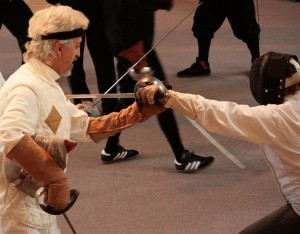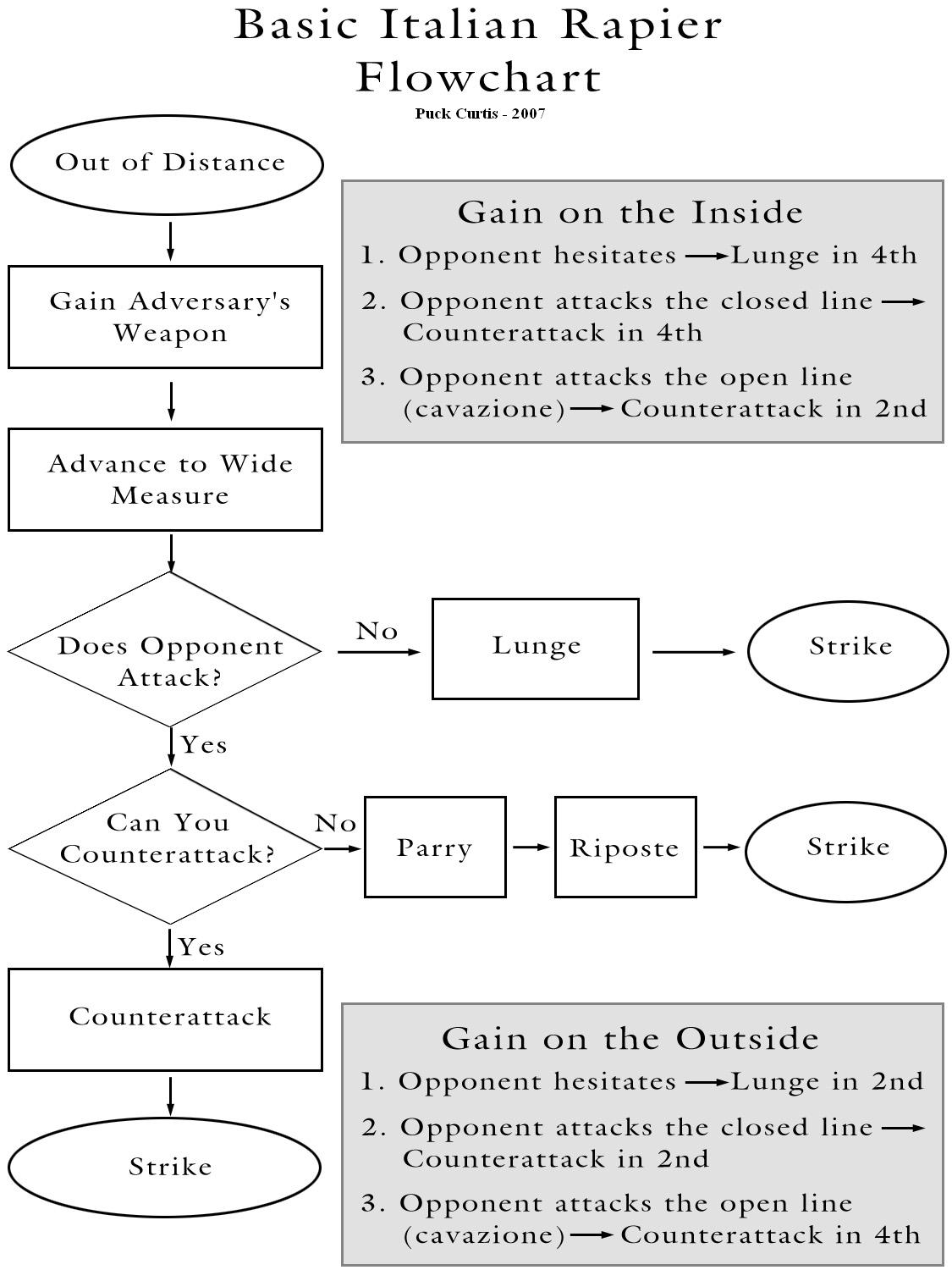You are reading the archive for the category: Opinion
Filed as Classical Fencing, Destreza (Spanish swordplay), Fencing, Geek Stuff, General, Historical Fencing, Opinion with Comments Off on Challenging the status quo without losing yourself
I have been in the situation where I felt I needed to challenge the conventional wisdom about a sword tradition and there are good ways and bad ways to tackle that problem.

Beware when fighting monsters that you don’t become one yourself.
First:
In my opinion, it is most effective to concentrate on the **work** instead of the **person** in the counterargument. If you have a position there’s a decent chance we want to hear it, hell, we need to hear it if the position has merit.
However, not all positions are good and we have seen plenty of half-baked nonsense in our time. Polish up your argument into its best form, have a friend read it for tone and clarity, and set it out there without assigning intention or motivations to the other researcher or the original author (unless the source definitively tells you, “By this I mean X, Y, Z…”)
Good work can be made better by critical process. I’ve been wrong and errors in my work have been fixed by others. (“There is no such thing as a transversal step backwards.” Oops. Fixed it.) It is not wonderful to be wrong, but I would rather see my stuff fixed than propagate errors.
As an aside, translation is an art. The lovely Dr. Curtis did a presentation on a single passage from Don Quixote and how the translation style changed the outcome of each piece. That’s expected. Multiple translations in different styles is a feature. I think we all want access to the different insights, tone, and flavor that each translator brings to the text. If you want to disagree with a translation it is probably about choices made. You could say, “By making this choice, the emphasis on these keys aspects is missing. Or, “This choice loses this context which I think is essential.” That’s constructive and potentially useful to the neutral observer.
Second:
Take care of yourself first. When you form a critical position, how you do that will make a lasting impression on the people reading your argument. When you use ad hominem attacks, assign nefarious intention, or imply fraud you have gone beyond academic discourse into personal grudges. At that point you’re going to see friends and allies rally to defend the character of the original researcher. Once that starts it can be very difficult, even if you are absolutely correct, to have a productive discussion.
There are ways to challenge existing work without compromising your personal reputation. Sometimes it’s absolutely necessary to do this to foster growth in the community and to correct misconceptions. Maybe that necessary conflict is being driven by you and your work. I’ll be the first to admit that doing this well isn’t easy but if you can thread that needle you’re going to be an asset the community will continue to draw upon going forward.
Consider having a friend read your argument to pull out things with loaded words like “refused”, “obviously”, “clearly”, “ignores”, “deluded”, “recklessly”, and so on. What I want as a reader is the core of your argument presented in its best form. I can make decisions about the personal motivations on my own.
For example,
- I think there is real value in considering this alternative which I think better reflects X,Y,Z…
- By considering how the images were chosen we can gain insight into X,Y,Z…
- I think this is an error based on this <citation>. Based on that consider this alternative which allows us to…
Each of those methods helps the reader understand there is potential value in at least considering your position. By buttressing the argument with citations and avoiding loaded language you open up some space in the dialogue and you preserve and protect yourself by avoiding self-inflicted wounds.
Third:
Don’t be an authority and instead be a resource. I’ve seen multiple examples of individuals trying to be an authority (Maestro-cop to the universe) and their work collapses underneath them as their attempt to assert authority is outpaced by the increased knowledge of the growing community. Having had the benefit of watching these implosions I made a commitment to myself not to walk down the same road.
By refusing to own the tradition but rather trying to build and restore it, I permit myself the necessary space to be wrong and correct the work as I gather new evidence.
Finally:
If you have done enough research to disagree with an established interpretation, you have value whether you are right or wrong. By encouraging you to argue well, I hope to preserve your place in the community for my own selfish reasons. Critical feedback and challenging of existing work is essential to what we do. I hope you’ve got something useful and can present your work effectively.
Filed as General, Opinion, Politics and News with no replies
The ground is shaking.
- Confederate Flags being pulled down everywhere?
- ObamaCare upheld 6-3
- Same-sex marriage wins 5-4
What is going on?
This could have ended differently.
Back in 2008 I made the argument that the election was primarily about the Supreme Court. Barack Obama has done some things I didn’t like but there is no reasonable counterargument that a Republican president would have done better and Obama nominated two progressive justices to the highest court. If a Republican had won, we wouldn’t have healthcare reform and we certainly would have lost the same-sex marriage decision.
Sometimes change takes time and sometimes it happens quickly. This week seems like a seismic shift as shock-waves ripple outward. If you look at the balance of power in our heavily gerrymandered system you’ll find that we’re poised for rapid shifts as the people outpace the politics.
It may not look like it but the Millennials won big today because they put Obama in the white house over the objections of the older whiter voters. The Millennials are the largest generation in history and the most liberal in their politics. The oldest of these voters are in their mid-30s and the cohort won’t reach full fighting strength until 2018 when the youngest will be eligible to vote.

Millennials are the largest generation numbering at 95 million, compared to 78 million for the Baby Boomers.
2016 will be an election to watch but it will be nothing compared to 2020. After the 2020 census the United States will redraw the maps of political power. Look for more major quakes when the gerrymanders start collapsing.
That shaking that you feel in the ground is the stirring of a giant awakening to take the reins of power and her name is ‘Millennial’.
Filed as Classical Fencing, Destreza (Spanish swordplay), Fencing, General, Historical Fencing, Italian Rapier, Opinion with no replies

There is no point in dreams if they lack some measure of audacity.
It was January of 2000 and the world had survived the millennium bug. The place was Breckenridge, Colorado and a member of my wife’s family had a cabin near the ski resorts. There at the top of the mountain I got my first bit of instruction in the ancient art of skiing.
The first and last thing I heard was, “Lean forward,” and so I did. I began to slide down the mountain gaining speed. I had no way to steer and no idea what I should be doing. I found myself completely out of control and was headed towards the trees at increasing velocity. Before I painfully crashed I orchestrated a controlled wipe-out into the snow with poles, skis, and limbs all flying in different directions. The remainder of the day was a repeat of the same series of leanings forward with various wipe-outs. I got better instruction and learned how to stop by “snow-plowing”. By the end of the day I had learned how to turn and stop with the skis parallel.
Sometime ago I became interested in the study of incompetence and how incompetent people generally behave. Specifically I was interested in the meta-cognition of incompetence as studied by Justin Kruger and David Dunning who found that incompetent people were unable effectively to evaluate their own competence. This lack of ability to understand personal competence has been called the Dunning–Kruger effect and restated basically it means that incompetent people tend to overestimate their own level of skill.
Link to the study:
https://www.math.ucdavis.edu/~suh/metacognition.pdf
(For an academic study, this is riveting material to read especially as a researcher, teacher, or student of martial arts.)
Compare that to Carranza’s statement, “He who knows most doubts most.” Carranza adds the perfect corollary to the DK effect and uniting the two ideas has given me a basis for moving forward during difficult tasks. (As an example, when a prairie-born Okie is rolling down a mountain with skis tied to his feet.)
The point isn’t to belittle or slander incompetence; we’re all incompetent in some subjects. Instead, my goal was to develop strategies to understand and mitigate my own incompetence by reserving a healthy dose of doubt about my own ability and creating a series of tests to validate my own performance.
I am going to add my own rule which I learned in Breckenridge, “Lean forward.” We can paraphrase Voltaire to arrive at a similar statement, “Never let the perfect be the enemy of the good.” If I had become paralyzed with the fear of the many stumbles, spectacular wipe-outs, and public laughter at my misbegotten antics I might never have learned to ski that day.
We might best understand this as a Medio (or a virtuous mean or balance point as Aristotle and the Destreza authors might describe it). There is absolute perfection at one extreme. At the other extreme is complete incompetence. Between the two extremes is the good work we might do if we just lean forward and accept our imperfection.
We need to teach and practice La Verdadera Destreza to build our skill and to foster a community. But, we also know not all the work has been translated which should be a warning to us to preserve our doubts. Previous attempts have stumbled and fallen quite publicly. Worse, our mistakes may be mocked and picked apart and ridiculed by our peers.
1. Know that your ability to self-evaluate is shaky while you are learning.
2. Preserve a healthy doubt and create meaningful checks to ensure your work is good.
3. Lean forward and be ambitious unto audacity. Don’t let the fear of failure prevent you from producing work.
Filed as Classical Fencing, Destreza (Spanish swordplay), Fencing, Historical Fencing, Italian Rapier, Opinion with no replies
Fencers? Cocky? Never!

William provides Italian sabre feedback at WMAW 2009
I recently witnessed an Internet discussion on fencing that rapidly degenerated into bad blood. Using my best sarcastic voice, I hereby state, “It may surprise the world to learn that fencers are notoriously cocky and prone to confrontation.”
Any fencing teacher can watch a fencing match and provide valid criticism and feedback. Regardless of the quality of the fencing in question, how your criticism is delivered tells the world what kind of person you are. More specifically, they get a window into how you might treat your own student.
If your goal is to humiliate and punish the student you are certainly welcome to say whatever you like, but I have a three-point system for delivering feedback based on my experiences training for the fencing master’s program.
Puck’s 3 Rules for Corrective Feedback
- Precise – Feedback should not be vague. “Fix your arm” is not an acceptable correction from a fencing teacher. That could mean anything. You do not want the student trying to guess what they should correct. “Extend your weapon arm first during the lunge;” “In the guard create a straight line from elbow to weapon tip;” “Close the line when striking.” These are all specific corrections tightly focused on the problem.
- Concise – Nothing breaks up the tempo of a fencing lesson like veering off into an extended discussion of tangential theory. There is a place for extended discussion, but on the floor a short and precise explanation preserves the flow of the lesson. Don’t let your fencer’s legs cool off while you wax poetic about the joys of striking in countertime. Importantly, don’t lecture while the student is on guard. If you are going to provide anything more than short feedback, put them into a resting posture like first position. Don’t spend sweat and energy having your student hold a guard as you prattle when you could spend that energy on fencing actions.
- Nice – This seems obvious, but it bears repeating. Don’t be a jerk when you deliver your correction. As a fencing teacher, you are engaged in the process of creating a skilled fencer. Like any person responsible for creation there will be challenges in the process. It is a poor artist that wrecks his own canvas. There is often a natural and friendly antagonism between the fencing master and the student, but the goal of the teacher should always be to build the student and not to destroy them.
Both fencing and teaching are very rewarding. Nothing worth doing is easy all the time, but if we can take a bit of time to treat each other with respect and focus on building better fencers we will all benefit.
~P.
Filed as Classical Fencing, Destreza (Spanish swordplay), Geek Stuff, General, Historical Fencing, Italian Rapier, Opinion, Reviews with 32 replies
(10/12/2009)
After WMAW 2007 I prepared this Italian rapier flowchart to explain some of the possible actions when executing tactical drills with a student.

Italian Rapier Flowchart (Click for High Resolution)
There are things I would change about this chart today. This flowchart does not include actions like attacks to the leg, the use of the off hand, and it doesn’t get into detail about execution, but as a basic learning aid I still like it provided the instructor does not limit the instruction solely to this decision tree.
~P.






